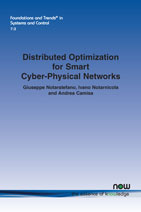Distributed Optimization for Smart Cyber-Physical Networks
Giuseppe Notarstefano, University of Bologna, Italy, giuseppe.notarstefano@unibo.it , Ivano Notarnicola, University of Bologna, Italy, ivano.notarnicola@unibo.it , Andrea Camisa, University of Bologna, Italy, a.camisa@unibo.itAbstract
The presence of embedded electronics and communication capabilities as well as sensing and control in smart devices has given rise to the novel concept of cyber-physical networks, in which agents aim at cooperatively solving complex tasks by local computation and communication. Numerous estimation, learning, decision and control tasks in smart networks involve the solution of large-scale, structured optimization problems in which network agents have only a partial knowledge of the whole problem. Distributed optimization aims at designing local computation and communication rules for the network processors allowing them to cooperatively solve the global optimization problem without relying on any central unit. The purpose of this survey is to provide an introduction to distributed optimization methodologies. Principal approaches, namely (primal) consensus-based, duality-based and constraint exchange methods, are formalized. An analysis of the basic schemes is supplied, and state-of-the-art extensions are reviewed.
Distributed Optimization for Smart Cyber-Physical Networks
In an increasingly connected world, the term cyber-physical networks has been coined to refer to the communication among devices that is turning smart devices into smart (cooperating) systems. The distinctive feature of such systems is that significant advantage can be obtained if its interconnected, complex nature is exploited. Several challenges arising in cyber-physical networks can be stated as optimization problems. Examples are estimation, decision, learning and control applications. In cyber-physical networks, the goal is to design algorithms, based on the exchange of information among the processors, that take advantage of the aggregated computational power.
Distributed Optimization for Smart Cyber-Physical Networks provides a comprehensive overview of the most common approaches used to design distributed optimization algorithms, together with the theoretical analysis of the main schemes in their basic version. It identifies and formalizes classes of problem set-ups that arise in motivating application scenarios. For each set-up, in order to give the main tools for analysis, tailored distributed algorithms in simplified cases are reviewed. Extensions and generalizations of the basic schemes are also discussed at the end of each chapter.
Distributed Optimization for Smart Cyber-Physical Networks provides the reader with an accessible overview of the current research and gives important pointers towards new developments. It is an excellent starting point for research and students unfamiliar with the topic.
